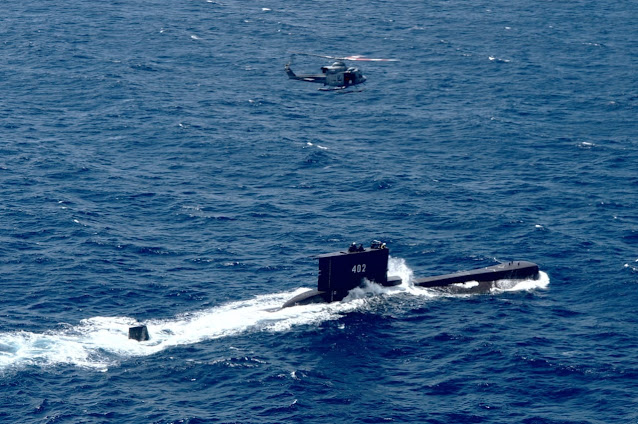Indonesian Military Says Missing Submarine Sank in Deep Water off Bali
pada tanggal
Sunday, April 25, 2021
DENPASAR, LELEMUKU.COM - Hopes for the survival of 53 sailors aboard a missing Indonesian Navy submarine dimmed Saturday when the military announced that the vessel sank and may have cracked and disintegrated in deep water off Bali as it went down.
Senior armed forces officials pointed to debris and objects from the submarine that were recovered in the ongoing search for the KRI Nanggala-402 as evidence of cracks that caused it to sink hundreds of meters below the surface of the Bali Sea.
The submersible boat lost radio contact after being cleared to dive during a torpedo training exercise early Wednesday morning.
“The search has shifted to the sub sunk phase, from the sub miss phase,” Air Marshal Hadi Tjahjanto, the chief of the armed forces, told reporters in Bali, using a military term for a missing submarine.
The recovered items included a part used in the submarine’s torpedo system, a heat insulator and a bottle of lubricant for greasing the periscope, officials said as they displayed the recovered objects during a press conference at a military base on Bali. A Muslim prayer rug from the submarine was also recovered, they said.
“These objects would have never slipped out of the submarine unless there was pressure or cracks,” Hadi said.
Navy Chief Adm. Yudo Margono indicated that the crew’s chances of survival were slim, but he and other military officials declined to say out right whether all the sailors on the submarine had perished, when reporters pressed them on this question.
“It did not explode, but there was a crack due to the depth of 700 meters [2,296 feet]. The pressure was so high that there could have been cracks in the submarine,” the Navy chief said.
Water might have flooded the submarine because of cracks but part of the submarine’s cabin could be compartmentalized to prevent more seawater from coming in provided that the hatches were closed, Yudo said.
“Seventy-two hours is the maximum limit in the event of an electrical blackout, but it can last up to five days if the electricity is on. But we suspect that there was a blackout,” he said, referring to the submarine’s oxygen supply, which had been expected to run out early Saturday.
“We have tried our best to find the KRI Nanggala, but this morning was the deadline for oxygen life support to run out. Oil spills and debris have become authentic evidence of Nanggala’s sinking,” Hadi said.
No bodies have been found so far, according to Yudo.
“We are still carrying out the search ... the depth of the sea we have detected is at 850 meters (2,790 feet), which is very tricky and presents many difficulties,” Reuters quoted the admiral as saying.
The announcement came as an Australian frigate, the HMAS Ballarat, and a U.S. military reconnaissance aircraft arrived in Bali to join dozens of Indonesian vessels that have scoured the sea to locate the submarine during the past few days.
Singapore’s submarine-rescue ship, the MV Swift Rescue, was expected to arrive later on Saturday, the Navy said.
Malaysia and India are also sending ships to support the search effort.
The Indonesian military believes that the submarine sank to between 600 and 700 meters below the surface – far deeper than the German-made vessel was designed to dive.
Yudo said Singapore’s MV Swift Rescue ship and a similar vessel from Malaysia had remotely operated vehicles that could reach depths of 900 to 1000 meters.
The Ballarat is equipped with sonar technology that could detect underwater objects, he said.
“Together, all teams will work hard because the depth of the sea is 850 meters and it will be extremely hard to do lifting and evacuation work,” Yudo said.
The KRI Nanggala-402 was built by German company Howaldtswerke-Deutsche Werft in 1977 and came into service in 1981, the Indonesian military said.
From 2009 to 2012, the submarine was retrofitted by South Korea’s Daewoo Shipbuilding & Marine Engineering, officials said.
Indonesia has five submarines, including the missing one.
Former Rear Adm. Soleman Ponto said the Nanggala might have broken up because the hull could no longer withstand the pressure.
“It is unlikely that they will survive,” he told BenarNews, referring to the crew.
“When pressure is high, the submarine will crumble like a squeezed tin – flattened.” (Tria Dianti | Benarnews)


